Brand Management Report: P&G, Gillette, and Brand Equity Analysis
VerifiedAdded on 2020/12/29
|19
|6090
|83
Report
AI Summary
This report provides a comprehensive analysis of brand management, focusing on Optimum Impressive Ltd and Proctor & Gamble (P&G). It begins with an introduction to brand management, defining key concepts like brand equity and brand building. The report includes a marketing brochure article, and then analyzes P&G's brand portfolio strategy, illustrating its hierarchy management. It explores strategies for managing brand equity, including Keller's model, brand extension, and revitalization. Furthermore, the report examines the strengths and weaknesses of the Gillette brand, along with partnership and collaborative agreements. Finally, it discusses measuring and managing brand value, covering brand awareness, market share, and customer attitudes. The report concludes by emphasizing the importance of branding for business success.
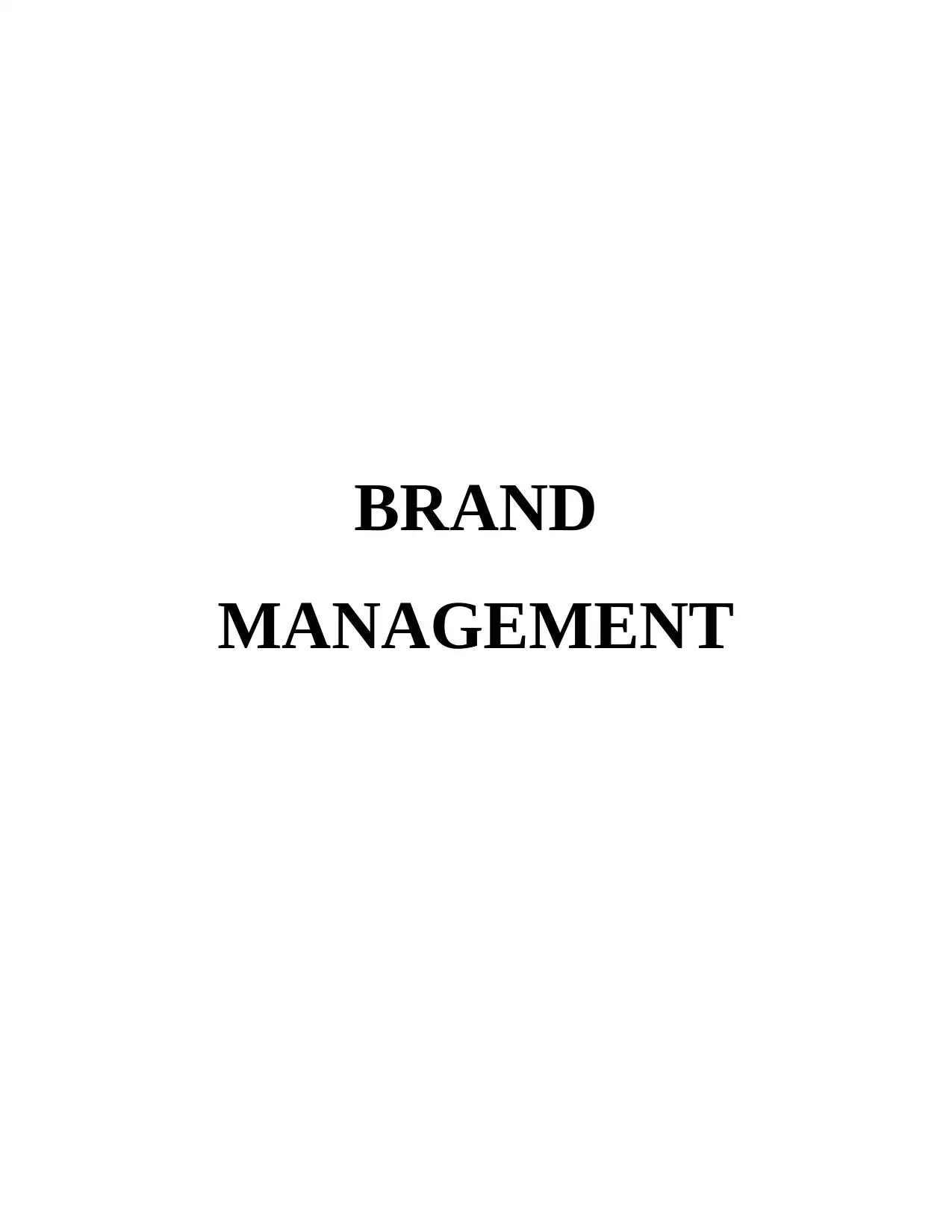
BRAND
MANAGEMENT
MANAGEMENT
Paraphrase This Document
Need a fresh take? Get an instant paraphrase of this document with our AI Paraphraser
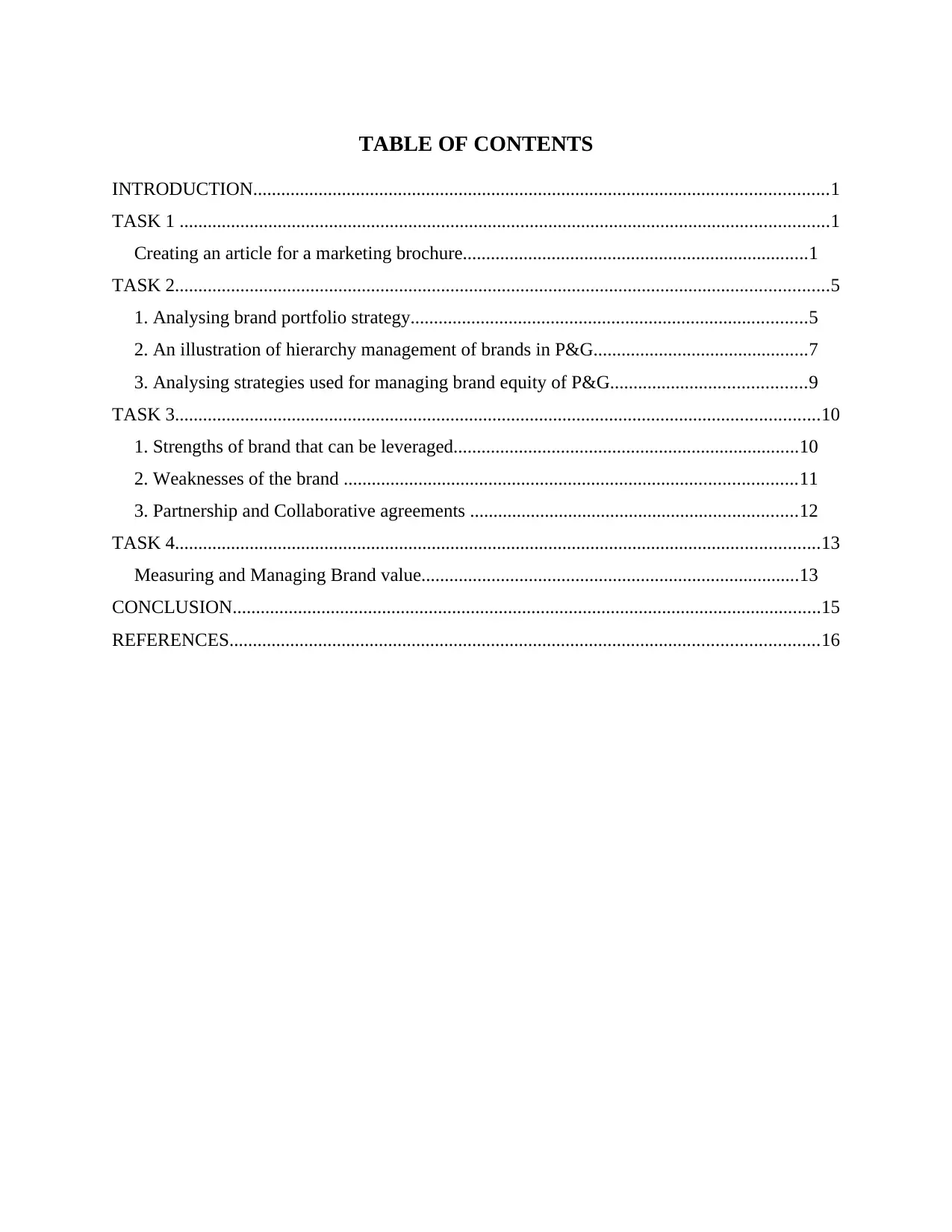
TABLE OF CONTENTS
INTRODUCTION...........................................................................................................................1
TASK 1 ...........................................................................................................................................1
Creating an article for a marketing brochure..........................................................................1
TASK 2............................................................................................................................................5
1. Analysing brand portfolio strategy.....................................................................................5
2. An illustration of hierarchy management of brands in P&G..............................................7
3. Analysing strategies used for managing brand equity of P&G..........................................9
TASK 3..........................................................................................................................................10
1. Strengths of brand that can be leveraged..........................................................................10
2. Weaknesses of the brand .................................................................................................11
3. Partnership and Collaborative agreements ......................................................................12
TASK 4..........................................................................................................................................13
Measuring and Managing Brand value.................................................................................13
CONCLUSION..............................................................................................................................15
REFERENCES..............................................................................................................................16
INTRODUCTION...........................................................................................................................1
TASK 1 ...........................................................................................................................................1
Creating an article for a marketing brochure..........................................................................1
TASK 2............................................................................................................................................5
1. Analysing brand portfolio strategy.....................................................................................5
2. An illustration of hierarchy management of brands in P&G..............................................7
3. Analysing strategies used for managing brand equity of P&G..........................................9
TASK 3..........................................................................................................................................10
1. Strengths of brand that can be leveraged..........................................................................10
2. Weaknesses of the brand .................................................................................................11
3. Partnership and Collaborative agreements ......................................................................12
TASK 4..........................................................................................................................................13
Measuring and Managing Brand value.................................................................................13
CONCLUSION..............................................................................................................................15
REFERENCES..............................................................................................................................16
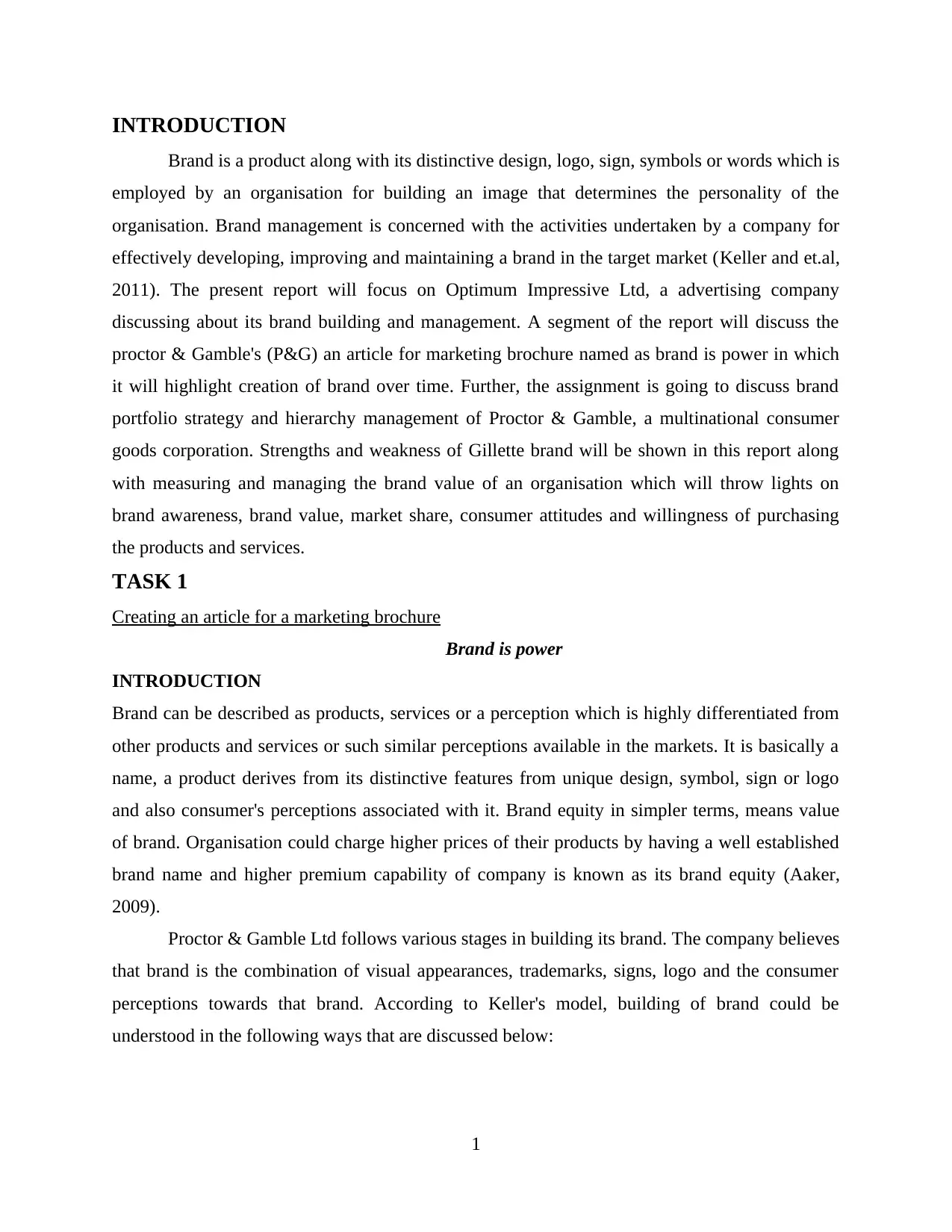
INTRODUCTION
Brand is a product along with its distinctive design, logo, sign, symbols or words which is
employed by an organisation for building an image that determines the personality of the
organisation. Brand management is concerned with the activities undertaken by a company for
effectively developing, improving and maintaining a brand in the target market (Keller and et.al,
2011). The present report will focus on Optimum Impressive Ltd, a advertising company
discussing about its brand building and management. A segment of the report will discuss the
proctor & Gamble's (P&G) an article for marketing brochure named as brand is power in which
it will highlight creation of brand over time. Further, the assignment is going to discuss brand
portfolio strategy and hierarchy management of Proctor & Gamble, a multinational consumer
goods corporation. Strengths and weakness of Gillette brand will be shown in this report along
with measuring and managing the brand value of an organisation which will throw lights on
brand awareness, brand value, market share, consumer attitudes and willingness of purchasing
the products and services.
TASK 1
Creating an article for a marketing brochure
Brand is power
INTRODUCTION
Brand can be described as products, services or a perception which is highly differentiated from
other products and services or such similar perceptions available in the markets. It is basically a
name, a product derives from its distinctive features from unique design, symbol, sign or logo
and also consumer's perceptions associated with it. Brand equity in simpler terms, means value
of brand. Organisation could charge higher prices of their products by having a well established
brand name and higher premium capability of company is known as its brand equity (Aaker,
2009).
Proctor & Gamble Ltd follows various stages in building its brand. The company believes
that brand is the combination of visual appearances, trademarks, signs, logo and the consumer
perceptions towards that brand. According to Keller's model, building of brand could be
understood in the following ways that are discussed below:
1
Brand is a product along with its distinctive design, logo, sign, symbols or words which is
employed by an organisation for building an image that determines the personality of the
organisation. Brand management is concerned with the activities undertaken by a company for
effectively developing, improving and maintaining a brand in the target market (Keller and et.al,
2011). The present report will focus on Optimum Impressive Ltd, a advertising company
discussing about its brand building and management. A segment of the report will discuss the
proctor & Gamble's (P&G) an article for marketing brochure named as brand is power in which
it will highlight creation of brand over time. Further, the assignment is going to discuss brand
portfolio strategy and hierarchy management of Proctor & Gamble, a multinational consumer
goods corporation. Strengths and weakness of Gillette brand will be shown in this report along
with measuring and managing the brand value of an organisation which will throw lights on
brand awareness, brand value, market share, consumer attitudes and willingness of purchasing
the products and services.
TASK 1
Creating an article for a marketing brochure
Brand is power
INTRODUCTION
Brand can be described as products, services or a perception which is highly differentiated from
other products and services or such similar perceptions available in the markets. It is basically a
name, a product derives from its distinctive features from unique design, symbol, sign or logo
and also consumer's perceptions associated with it. Brand equity in simpler terms, means value
of brand. Organisation could charge higher prices of their products by having a well established
brand name and higher premium capability of company is known as its brand equity (Aaker,
2009).
Proctor & Gamble Ltd follows various stages in building its brand. The company believes
that brand is the combination of visual appearances, trademarks, signs, logo and the consumer
perceptions towards that brand. According to Keller's model, building of brand could be
understood in the following ways that are discussed below:
1
⊘ This is a preview!⊘
Do you want full access?
Subscribe today to unlock all pages.

Trusted by 1+ million students worldwide
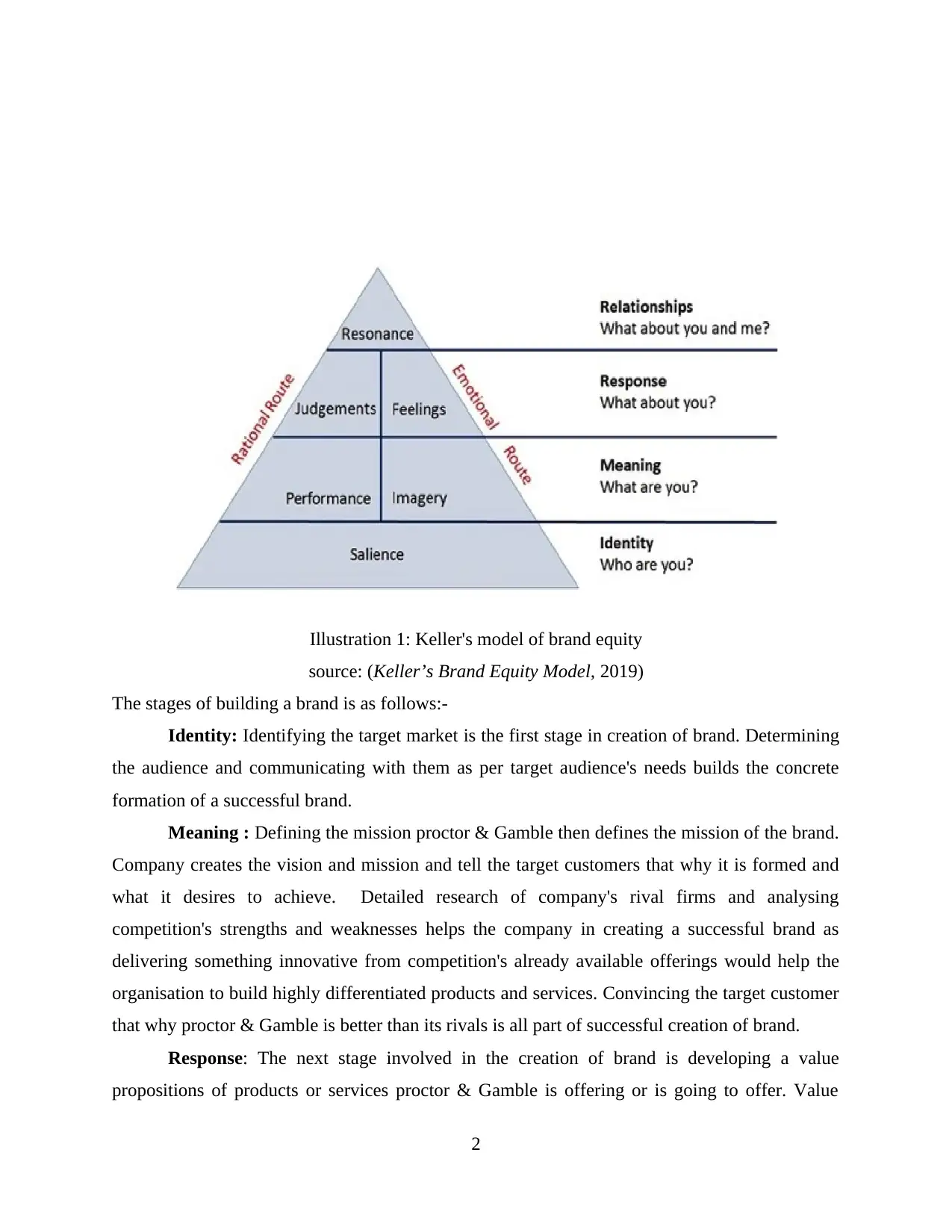
Illustration 1: Keller's model of brand equity
source: (Keller’s Brand Equity Model, 2019)
The stages of building a brand is as follows:-
Identity: Identifying the target market is the first stage in creation of brand. Determining
the audience and communicating with them as per target audience's needs builds the concrete
formation of a successful brand.
Meaning : Defining the mission proctor & Gamble then defines the mission of the brand.
Company creates the vision and mission and tell the target customers that why it is formed and
what it desires to achieve. Detailed research of company's rival firms and analysing
competition's strengths and weaknesses helps the company in creating a successful brand as
delivering something innovative from competition's already available offerings would help the
organisation to build highly differentiated products and services. Convincing the target customer
that why proctor & Gamble is better than its rivals is all part of successful creation of brand.
Response: The next stage involved in the creation of brand is developing a value
propositions of products or services proctor & Gamble is offering or is going to offer. Value
2
source: (Keller’s Brand Equity Model, 2019)
The stages of building a brand is as follows:-
Identity: Identifying the target market is the first stage in creation of brand. Determining
the audience and communicating with them as per target audience's needs builds the concrete
formation of a successful brand.
Meaning : Defining the mission proctor & Gamble then defines the mission of the brand.
Company creates the vision and mission and tell the target customers that why it is formed and
what it desires to achieve. Detailed research of company's rival firms and analysing
competition's strengths and weaknesses helps the company in creating a successful brand as
delivering something innovative from competition's already available offerings would help the
organisation to build highly differentiated products and services. Convincing the target customer
that why proctor & Gamble is better than its rivals is all part of successful creation of brand.
Response: The next stage involved in the creation of brand is developing a value
propositions of products or services proctor & Gamble is offering or is going to offer. Value
2
Paraphrase This Document
Need a fresh take? Get an instant paraphrase of this document with our AI Paraphraser
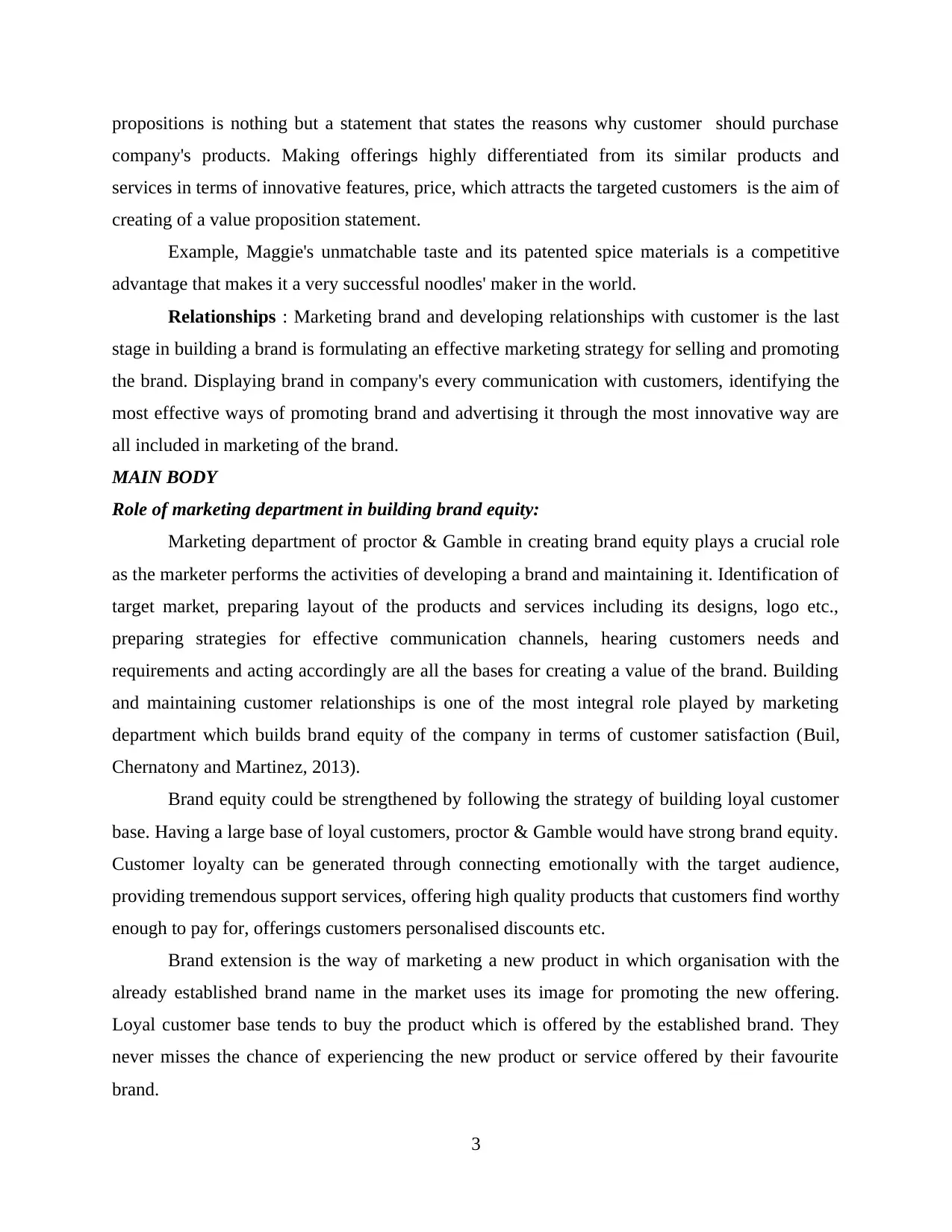
propositions is nothing but a statement that states the reasons why customer should purchase
company's products. Making offerings highly differentiated from its similar products and
services in terms of innovative features, price, which attracts the targeted customers is the aim of
creating of a value proposition statement.
Example, Maggie's unmatchable taste and its patented spice materials is a competitive
advantage that makes it a very successful noodles' maker in the world.
Relationships : Marketing brand and developing relationships with customer is the last
stage in building a brand is formulating an effective marketing strategy for selling and promoting
the brand. Displaying brand in company's every communication with customers, identifying the
most effective ways of promoting brand and advertising it through the most innovative way are
all included in marketing of the brand.
MAIN BODY
Role of marketing department in building brand equity:
Marketing department of proctor & Gamble in creating brand equity plays a crucial role
as the marketer performs the activities of developing a brand and maintaining it. Identification of
target market, preparing layout of the products and services including its designs, logo etc.,
preparing strategies for effective communication channels, hearing customers needs and
requirements and acting accordingly are all the bases for creating a value of the brand. Building
and maintaining customer relationships is one of the most integral role played by marketing
department which builds brand equity of the company in terms of customer satisfaction (Buil,
Chernatony and Martinez, 2013).
Brand equity could be strengthened by following the strategy of building loyal customer
base. Having a large base of loyal customers, proctor & Gamble would have strong brand equity.
Customer loyalty can be generated through connecting emotionally with the target audience,
providing tremendous support services, offering high quality products that customers find worthy
enough to pay for, offerings customers personalised discounts etc.
Brand extension is the way of marketing a new product in which organisation with the
already established brand name in the market uses its image for promoting the new offering.
Loyal customer base tends to buy the product which is offered by the established brand. They
never misses the chance of experiencing the new product or service offered by their favourite
brand.
3
company's products. Making offerings highly differentiated from its similar products and
services in terms of innovative features, price, which attracts the targeted customers is the aim of
creating of a value proposition statement.
Example, Maggie's unmatchable taste and its patented spice materials is a competitive
advantage that makes it a very successful noodles' maker in the world.
Relationships : Marketing brand and developing relationships with customer is the last
stage in building a brand is formulating an effective marketing strategy for selling and promoting
the brand. Displaying brand in company's every communication with customers, identifying the
most effective ways of promoting brand and advertising it through the most innovative way are
all included in marketing of the brand.
MAIN BODY
Role of marketing department in building brand equity:
Marketing department of proctor & Gamble in creating brand equity plays a crucial role
as the marketer performs the activities of developing a brand and maintaining it. Identification of
target market, preparing layout of the products and services including its designs, logo etc.,
preparing strategies for effective communication channels, hearing customers needs and
requirements and acting accordingly are all the bases for creating a value of the brand. Building
and maintaining customer relationships is one of the most integral role played by marketing
department which builds brand equity of the company in terms of customer satisfaction (Buil,
Chernatony and Martinez, 2013).
Brand equity could be strengthened by following the strategy of building loyal customer
base. Having a large base of loyal customers, proctor & Gamble would have strong brand equity.
Customer loyalty can be generated through connecting emotionally with the target audience,
providing tremendous support services, offering high quality products that customers find worthy
enough to pay for, offerings customers personalised discounts etc.
Brand extension is the way of marketing a new product in which organisation with the
already established brand name in the market uses its image for promoting the new offering.
Loyal customer base tends to buy the product which is offered by the established brand. They
never misses the chance of experiencing the new product or service offered by their favourite
brand.
3
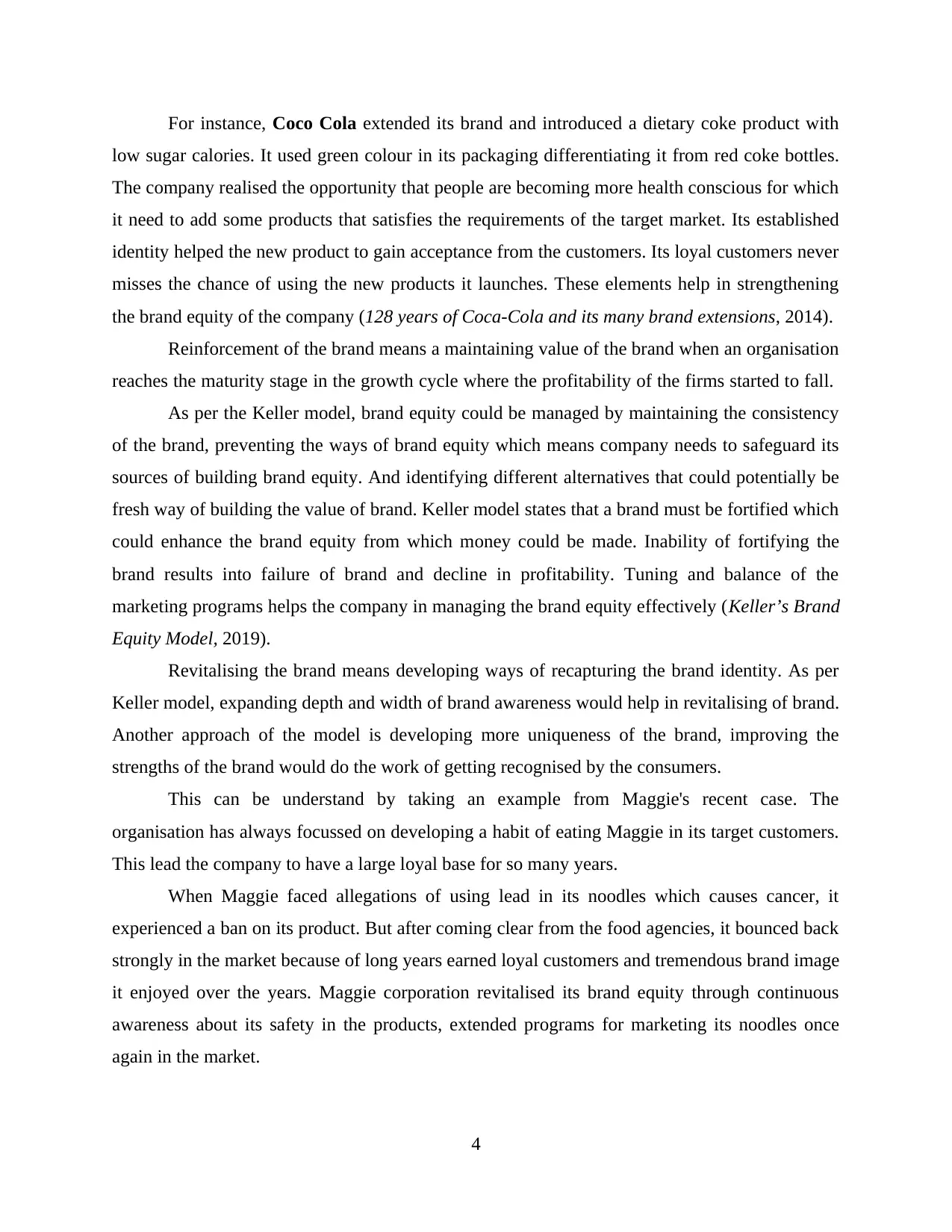
For instance, Coco Cola extended its brand and introduced a dietary coke product with
low sugar calories. It used green colour in its packaging differentiating it from red coke bottles.
The company realised the opportunity that people are becoming more health conscious for which
it need to add some products that satisfies the requirements of the target market. Its established
identity helped the new product to gain acceptance from the customers. Its loyal customers never
misses the chance of using the new products it launches. These elements help in strengthening
the brand equity of the company (128 years of Coca-Cola and its many brand extensions, 2014).
Reinforcement of the brand means a maintaining value of the brand when an organisation
reaches the maturity stage in the growth cycle where the profitability of the firms started to fall.
As per the Keller model, brand equity could be managed by maintaining the consistency
of the brand, preventing the ways of brand equity which means company needs to safeguard its
sources of building brand equity. And identifying different alternatives that could potentially be
fresh way of building the value of brand. Keller model states that a brand must be fortified which
could enhance the brand equity from which money could be made. Inability of fortifying the
brand results into failure of brand and decline in profitability. Tuning and balance of the
marketing programs helps the company in managing the brand equity effectively (Keller’s Brand
Equity Model, 2019).
Revitalising the brand means developing ways of recapturing the brand identity. As per
Keller model, expanding depth and width of brand awareness would help in revitalising of brand.
Another approach of the model is developing more uniqueness of the brand, improving the
strengths of the brand would do the work of getting recognised by the consumers.
This can be understand by taking an example from Maggie's recent case. The
organisation has always focussed on developing a habit of eating Maggie in its target customers.
This lead the company to have a large loyal base for so many years.
When Maggie faced allegations of using lead in its noodles which causes cancer, it
experienced a ban on its product. But after coming clear from the food agencies, it bounced back
strongly in the market because of long years earned loyal customers and tremendous brand image
it enjoyed over the years. Maggie corporation revitalised its brand equity through continuous
awareness about its safety in the products, extended programs for marketing its noodles once
again in the market.
4
low sugar calories. It used green colour in its packaging differentiating it from red coke bottles.
The company realised the opportunity that people are becoming more health conscious for which
it need to add some products that satisfies the requirements of the target market. Its established
identity helped the new product to gain acceptance from the customers. Its loyal customers never
misses the chance of using the new products it launches. These elements help in strengthening
the brand equity of the company (128 years of Coca-Cola and its many brand extensions, 2014).
Reinforcement of the brand means a maintaining value of the brand when an organisation
reaches the maturity stage in the growth cycle where the profitability of the firms started to fall.
As per the Keller model, brand equity could be managed by maintaining the consistency
of the brand, preventing the ways of brand equity which means company needs to safeguard its
sources of building brand equity. And identifying different alternatives that could potentially be
fresh way of building the value of brand. Keller model states that a brand must be fortified which
could enhance the brand equity from which money could be made. Inability of fortifying the
brand results into failure of brand and decline in profitability. Tuning and balance of the
marketing programs helps the company in managing the brand equity effectively (Keller’s Brand
Equity Model, 2019).
Revitalising the brand means developing ways of recapturing the brand identity. As per
Keller model, expanding depth and width of brand awareness would help in revitalising of brand.
Another approach of the model is developing more uniqueness of the brand, improving the
strengths of the brand would do the work of getting recognised by the consumers.
This can be understand by taking an example from Maggie's recent case. The
organisation has always focussed on developing a habit of eating Maggie in its target customers.
This lead the company to have a large loyal base for so many years.
When Maggie faced allegations of using lead in its noodles which causes cancer, it
experienced a ban on its product. But after coming clear from the food agencies, it bounced back
strongly in the market because of long years earned loyal customers and tremendous brand image
it enjoyed over the years. Maggie corporation revitalised its brand equity through continuous
awareness about its safety in the products, extended programs for marketing its noodles once
again in the market.
4
⊘ This is a preview!⊘
Do you want full access?
Subscribe today to unlock all pages.

Trusted by 1+ million students worldwide
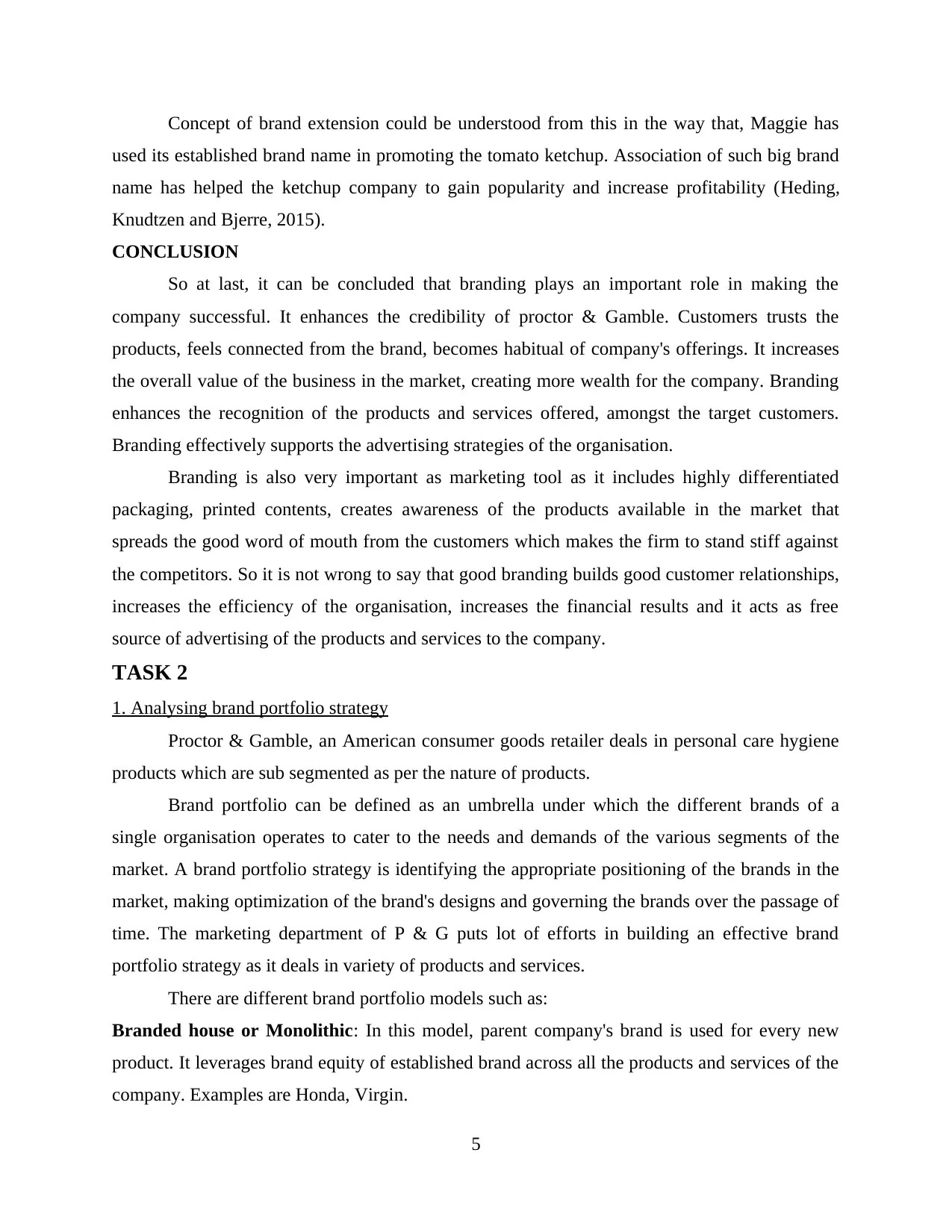
Concept of brand extension could be understood from this in the way that, Maggie has
used its established brand name in promoting the tomato ketchup. Association of such big brand
name has helped the ketchup company to gain popularity and increase profitability (Heding,
Knudtzen and Bjerre, 2015).
CONCLUSION
So at last, it can be concluded that branding plays an important role in making the
company successful. It enhances the credibility of proctor & Gamble. Customers trusts the
products, feels connected from the brand, becomes habitual of company's offerings. It increases
the overall value of the business in the market, creating more wealth for the company. Branding
enhances the recognition of the products and services offered, amongst the target customers.
Branding effectively supports the advertising strategies of the organisation.
Branding is also very important as marketing tool as it includes highly differentiated
packaging, printed contents, creates awareness of the products available in the market that
spreads the good word of mouth from the customers which makes the firm to stand stiff against
the competitors. So it is not wrong to say that good branding builds good customer relationships,
increases the efficiency of the organisation, increases the financial results and it acts as free
source of advertising of the products and services to the company.
TASK 2
1. Analysing brand portfolio strategy
Proctor & Gamble, an American consumer goods retailer deals in personal care hygiene
products which are sub segmented as per the nature of products.
Brand portfolio can be defined as an umbrella under which the different brands of a
single organisation operates to cater to the needs and demands of the various segments of the
market. A brand portfolio strategy is identifying the appropriate positioning of the brands in the
market, making optimization of the brand's designs and governing the brands over the passage of
time. The marketing department of P & G puts lot of efforts in building an effective brand
portfolio strategy as it deals in variety of products and services.
There are different brand portfolio models such as:
Branded house or Monolithic: In this model, parent company's brand is used for every new
product. It leverages brand equity of established brand across all the products and services of the
company. Examples are Honda, Virgin.
5
used its established brand name in promoting the tomato ketchup. Association of such big brand
name has helped the ketchup company to gain popularity and increase profitability (Heding,
Knudtzen and Bjerre, 2015).
CONCLUSION
So at last, it can be concluded that branding plays an important role in making the
company successful. It enhances the credibility of proctor & Gamble. Customers trusts the
products, feels connected from the brand, becomes habitual of company's offerings. It increases
the overall value of the business in the market, creating more wealth for the company. Branding
enhances the recognition of the products and services offered, amongst the target customers.
Branding effectively supports the advertising strategies of the organisation.
Branding is also very important as marketing tool as it includes highly differentiated
packaging, printed contents, creates awareness of the products available in the market that
spreads the good word of mouth from the customers which makes the firm to stand stiff against
the competitors. So it is not wrong to say that good branding builds good customer relationships,
increases the efficiency of the organisation, increases the financial results and it acts as free
source of advertising of the products and services to the company.
TASK 2
1. Analysing brand portfolio strategy
Proctor & Gamble, an American consumer goods retailer deals in personal care hygiene
products which are sub segmented as per the nature of products.
Brand portfolio can be defined as an umbrella under which the different brands of a
single organisation operates to cater to the needs and demands of the various segments of the
market. A brand portfolio strategy is identifying the appropriate positioning of the brands in the
market, making optimization of the brand's designs and governing the brands over the passage of
time. The marketing department of P & G puts lot of efforts in building an effective brand
portfolio strategy as it deals in variety of products and services.
There are different brand portfolio models such as:
Branded house or Monolithic: In this model, parent company's brand is used for every new
product. It leverages brand equity of established brand across all the products and services of the
company. Examples are Honda, Virgin.
5
Paraphrase This Document
Need a fresh take? Get an instant paraphrase of this document with our AI Paraphraser
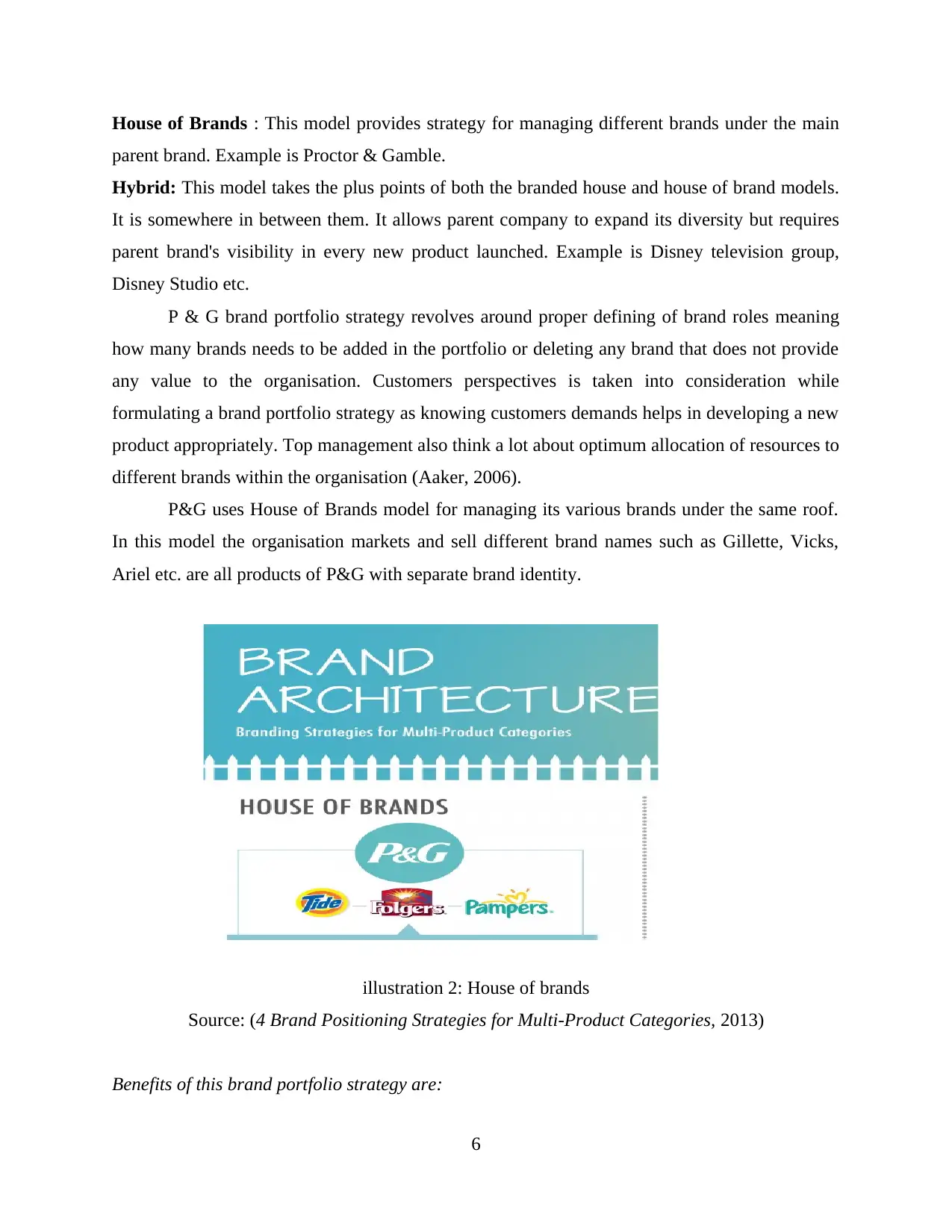
House of Brands : This model provides strategy for managing different brands under the main
parent brand. Example is Proctor & Gamble.
Hybrid: This model takes the plus points of both the branded house and house of brand models.
It is somewhere in between them. It allows parent company to expand its diversity but requires
parent brand's visibility in every new product launched. Example is Disney television group,
Disney Studio etc.
P & G brand portfolio strategy revolves around proper defining of brand roles meaning
how many brands needs to be added in the portfolio or deleting any brand that does not provide
any value to the organisation. Customers perspectives is taken into consideration while
formulating a brand portfolio strategy as knowing customers demands helps in developing a new
product appropriately. Top management also think a lot about optimum allocation of resources to
different brands within the organisation (Aaker, 2006).
P&G uses House of Brands model for managing its various brands under the same roof.
In this model the organisation markets and sell different brand names such as Gillette, Vicks,
Ariel etc. are all products of P&G with separate brand identity.
illustration 2: House of brands
Source: (4 Brand Positioning Strategies for Multi-Product Categories, 2013)
Benefits of this brand portfolio strategy are:
6
parent brand. Example is Proctor & Gamble.
Hybrid: This model takes the plus points of both the branded house and house of brand models.
It is somewhere in between them. It allows parent company to expand its diversity but requires
parent brand's visibility in every new product launched. Example is Disney television group,
Disney Studio etc.
P & G brand portfolio strategy revolves around proper defining of brand roles meaning
how many brands needs to be added in the portfolio or deleting any brand that does not provide
any value to the organisation. Customers perspectives is taken into consideration while
formulating a brand portfolio strategy as knowing customers demands helps in developing a new
product appropriately. Top management also think a lot about optimum allocation of resources to
different brands within the organisation (Aaker, 2006).
P&G uses House of Brands model for managing its various brands under the same roof.
In this model the organisation markets and sell different brand names such as Gillette, Vicks,
Ariel etc. are all products of P&G with separate brand identity.
illustration 2: House of brands
Source: (4 Brand Positioning Strategies for Multi-Product Categories, 2013)
Benefits of this brand portfolio strategy are:
6
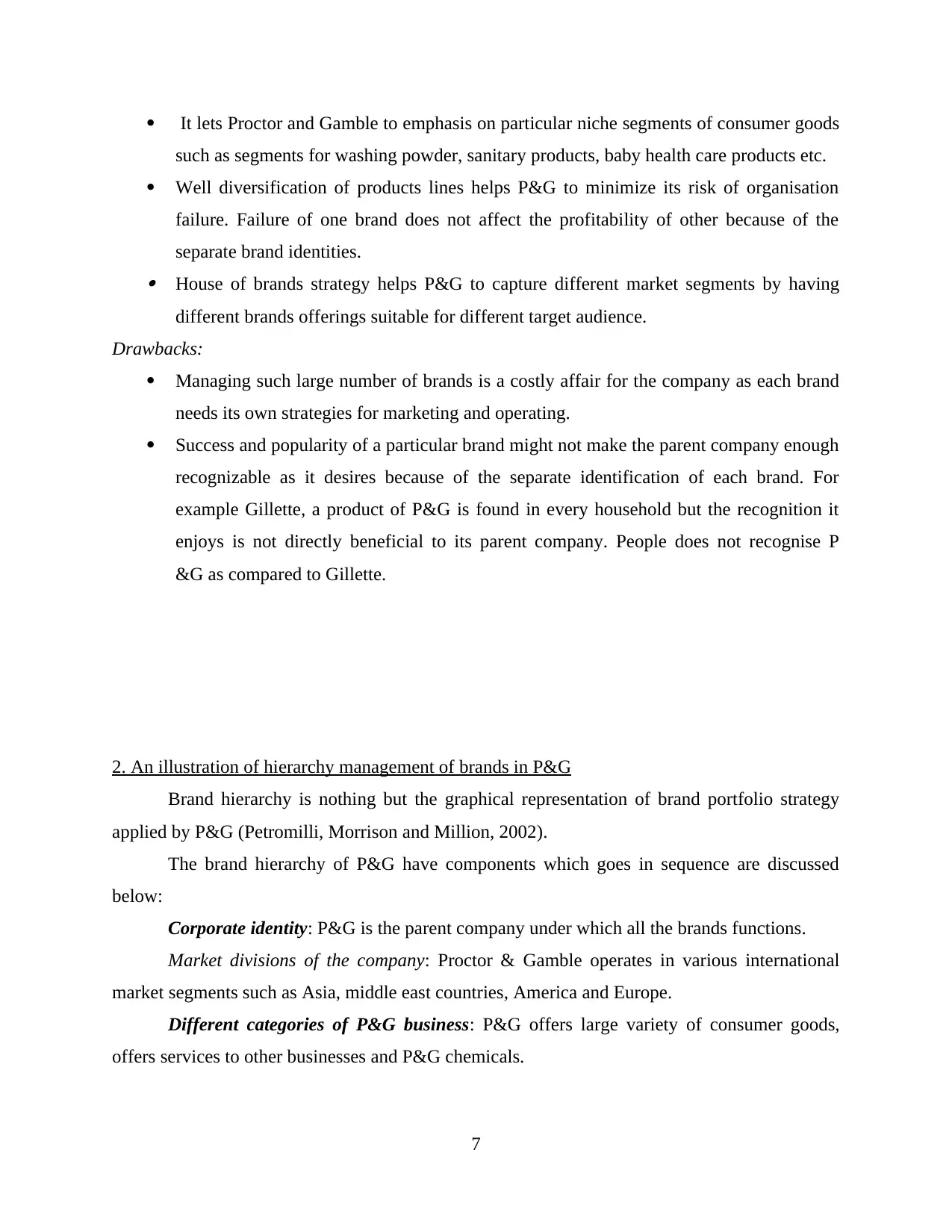
It lets Proctor and Gamble to emphasis on particular niche segments of consumer goods
such as segments for washing powder, sanitary products, baby health care products etc.
Well diversification of products lines helps P&G to minimize its risk of organisation
failure. Failure of one brand does not affect the profitability of other because of the
separate brand identities. House of brands strategy helps P&G to capture different market segments by having
different brands offerings suitable for different target audience.
Drawbacks:
Managing such large number of brands is a costly affair for the company as each brand
needs its own strategies for marketing and operating.
Success and popularity of a particular brand might not make the parent company enough
recognizable as it desires because of the separate identification of each brand. For
example Gillette, a product of P&G is found in every household but the recognition it
enjoys is not directly beneficial to its parent company. People does not recognise P
&G as compared to Gillette.
2. An illustration of hierarchy management of brands in P&G
Brand hierarchy is nothing but the graphical representation of brand portfolio strategy
applied by P&G (Petromilli, Morrison and Million, 2002).
The brand hierarchy of P&G have components which goes in sequence are discussed
below:
Corporate identity: P&G is the parent company under which all the brands functions.
Market divisions of the company: Proctor & Gamble operates in various international
market segments such as Asia, middle east countries, America and Europe.
Different categories of P&G business: P&G offers large variety of consumer goods,
offers services to other businesses and P&G chemicals.
7
such as segments for washing powder, sanitary products, baby health care products etc.
Well diversification of products lines helps P&G to minimize its risk of organisation
failure. Failure of one brand does not affect the profitability of other because of the
separate brand identities. House of brands strategy helps P&G to capture different market segments by having
different brands offerings suitable for different target audience.
Drawbacks:
Managing such large number of brands is a costly affair for the company as each brand
needs its own strategies for marketing and operating.
Success and popularity of a particular brand might not make the parent company enough
recognizable as it desires because of the separate identification of each brand. For
example Gillette, a product of P&G is found in every household but the recognition it
enjoys is not directly beneficial to its parent company. People does not recognise P
&G as compared to Gillette.
2. An illustration of hierarchy management of brands in P&G
Brand hierarchy is nothing but the graphical representation of brand portfolio strategy
applied by P&G (Petromilli, Morrison and Million, 2002).
The brand hierarchy of P&G have components which goes in sequence are discussed
below:
Corporate identity: P&G is the parent company under which all the brands functions.
Market divisions of the company: Proctor & Gamble operates in various international
market segments such as Asia, middle east countries, America and Europe.
Different categories of P&G business: P&G offers large variety of consumer goods,
offers services to other businesses and P&G chemicals.
7
⊘ This is a preview!⊘
Do you want full access?
Subscribe today to unlock all pages.

Trusted by 1+ million students worldwide
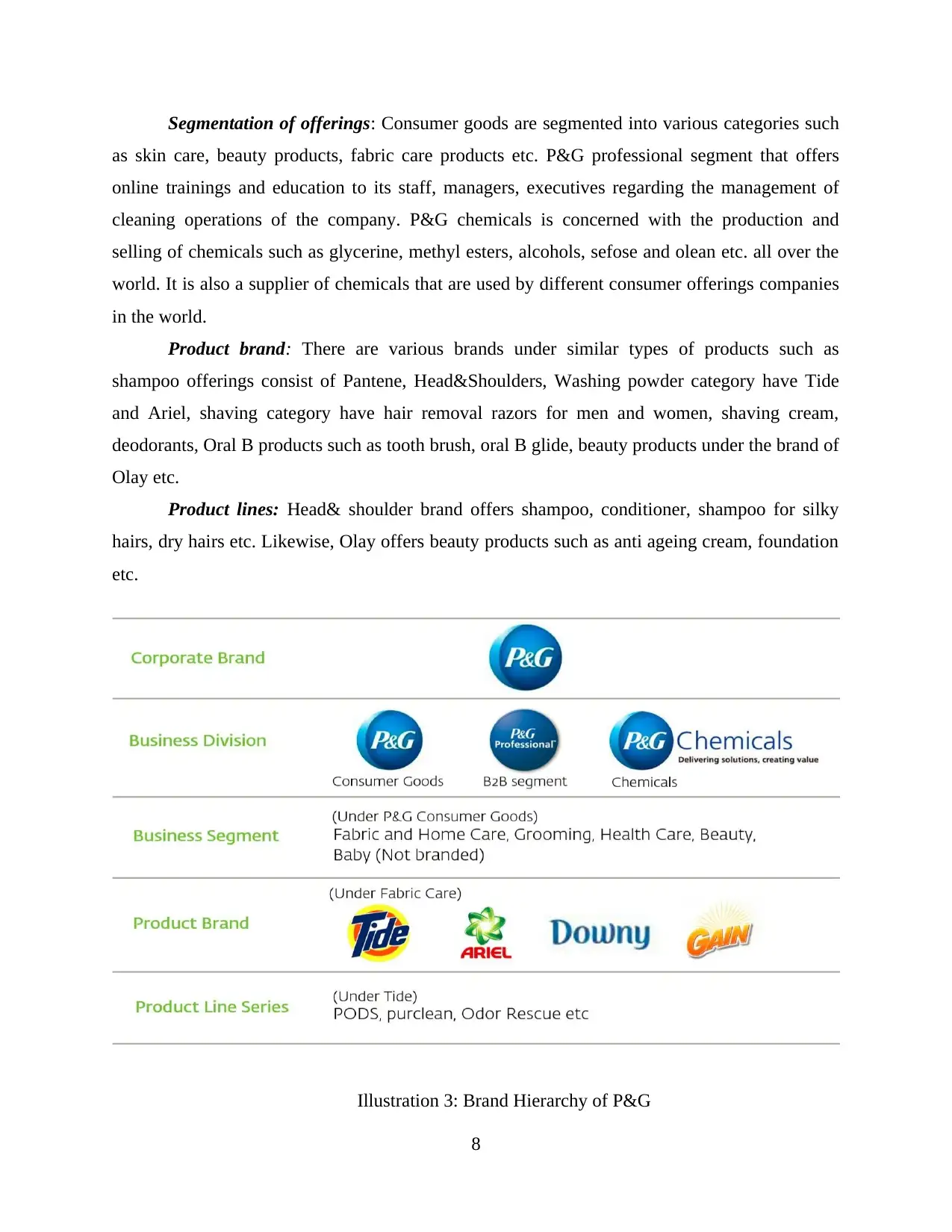
Segmentation of offerings: Consumer goods are segmented into various categories such
as skin care, beauty products, fabric care products etc. P&G professional segment that offers
online trainings and education to its staff, managers, executives regarding the management of
cleaning operations of the company. P&G chemicals is concerned with the production and
selling of chemicals such as glycerine, methyl esters, alcohols, sefose and olean etc. all over the
world. It is also a supplier of chemicals that are used by different consumer offerings companies
in the world.
Product brand: There are various brands under similar types of products such as
shampoo offerings consist of Pantene, Head&Shoulders, Washing powder category have Tide
and Ariel, shaving category have hair removal razors for men and women, shaving cream,
deodorants, Oral B products such as tooth brush, oral B glide, beauty products under the brand of
Olay etc.
Product lines: Head& shoulder brand offers shampoo, conditioner, shampoo for silky
hairs, dry hairs etc. Likewise, Olay offers beauty products such as anti ageing cream, foundation
etc.
Illustration 3: Brand Hierarchy of P&G
8
as skin care, beauty products, fabric care products etc. P&G professional segment that offers
online trainings and education to its staff, managers, executives regarding the management of
cleaning operations of the company. P&G chemicals is concerned with the production and
selling of chemicals such as glycerine, methyl esters, alcohols, sefose and olean etc. all over the
world. It is also a supplier of chemicals that are used by different consumer offerings companies
in the world.
Product brand: There are various brands under similar types of products such as
shampoo offerings consist of Pantene, Head&Shoulders, Washing powder category have Tide
and Ariel, shaving category have hair removal razors for men and women, shaving cream,
deodorants, Oral B products such as tooth brush, oral B glide, beauty products under the brand of
Olay etc.
Product lines: Head& shoulder brand offers shampoo, conditioner, shampoo for silky
hairs, dry hairs etc. Likewise, Olay offers beauty products such as anti ageing cream, foundation
etc.
Illustration 3: Brand Hierarchy of P&G
8
Paraphrase This Document
Need a fresh take? Get an instant paraphrase of this document with our AI Paraphraser
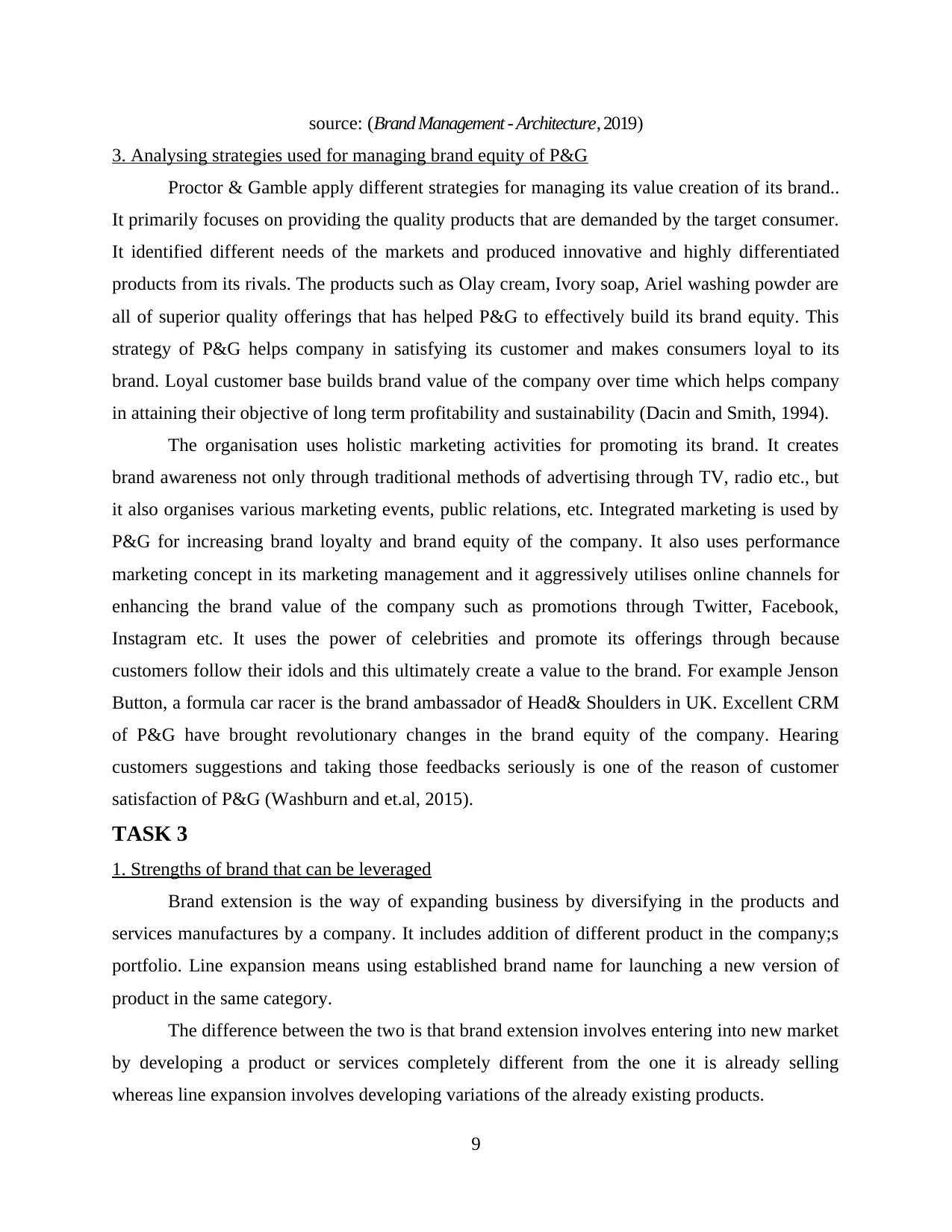
source: (Brand Management - Architecture, 2019)
3. Analysing strategies used for managing brand equity of P&G
Proctor & Gamble apply different strategies for managing its value creation of its brand..
It primarily focuses on providing the quality products that are demanded by the target consumer.
It identified different needs of the markets and produced innovative and highly differentiated
products from its rivals. The products such as Olay cream, Ivory soap, Ariel washing powder are
all of superior quality offerings that has helped P&G to effectively build its brand equity. This
strategy of P&G helps company in satisfying its customer and makes consumers loyal to its
brand. Loyal customer base builds brand value of the company over time which helps company
in attaining their objective of long term profitability and sustainability (Dacin and Smith, 1994).
The organisation uses holistic marketing activities for promoting its brand. It creates
brand awareness not only through traditional methods of advertising through TV, radio etc., but
it also organises various marketing events, public relations, etc. Integrated marketing is used by
P&G for increasing brand loyalty and brand equity of the company. It also uses performance
marketing concept in its marketing management and it aggressively utilises online channels for
enhancing the brand value of the company such as promotions through Twitter, Facebook,
Instagram etc. It uses the power of celebrities and promote its offerings through because
customers follow their idols and this ultimately create a value to the brand. For example Jenson
Button, a formula car racer is the brand ambassador of Head& Shoulders in UK. Excellent CRM
of P&G have brought revolutionary changes in the brand equity of the company. Hearing
customers suggestions and taking those feedbacks seriously is one of the reason of customer
satisfaction of P&G (Washburn and et.al, 2015).
TASK 3
1. Strengths of brand that can be leveraged
Brand extension is the way of expanding business by diversifying in the products and
services manufactures by a company. It includes addition of different product in the company;s
portfolio. Line expansion means using established brand name for launching a new version of
product in the same category.
The difference between the two is that brand extension involves entering into new market
by developing a product or services completely different from the one it is already selling
whereas line expansion involves developing variations of the already existing products.
9
3. Analysing strategies used for managing brand equity of P&G
Proctor & Gamble apply different strategies for managing its value creation of its brand..
It primarily focuses on providing the quality products that are demanded by the target consumer.
It identified different needs of the markets and produced innovative and highly differentiated
products from its rivals. The products such as Olay cream, Ivory soap, Ariel washing powder are
all of superior quality offerings that has helped P&G to effectively build its brand equity. This
strategy of P&G helps company in satisfying its customer and makes consumers loyal to its
brand. Loyal customer base builds brand value of the company over time which helps company
in attaining their objective of long term profitability and sustainability (Dacin and Smith, 1994).
The organisation uses holistic marketing activities for promoting its brand. It creates
brand awareness not only through traditional methods of advertising through TV, radio etc., but
it also organises various marketing events, public relations, etc. Integrated marketing is used by
P&G for increasing brand loyalty and brand equity of the company. It also uses performance
marketing concept in its marketing management and it aggressively utilises online channels for
enhancing the brand value of the company such as promotions through Twitter, Facebook,
Instagram etc. It uses the power of celebrities and promote its offerings through because
customers follow their idols and this ultimately create a value to the brand. For example Jenson
Button, a formula car racer is the brand ambassador of Head& Shoulders in UK. Excellent CRM
of P&G have brought revolutionary changes in the brand equity of the company. Hearing
customers suggestions and taking those feedbacks seriously is one of the reason of customer
satisfaction of P&G (Washburn and et.al, 2015).
TASK 3
1. Strengths of brand that can be leveraged
Brand extension is the way of expanding business by diversifying in the products and
services manufactures by a company. It includes addition of different product in the company;s
portfolio. Line expansion means using established brand name for launching a new version of
product in the same category.
The difference between the two is that brand extension involves entering into new market
by developing a product or services completely different from the one it is already selling
whereas line expansion involves developing variations of the already existing products.
9
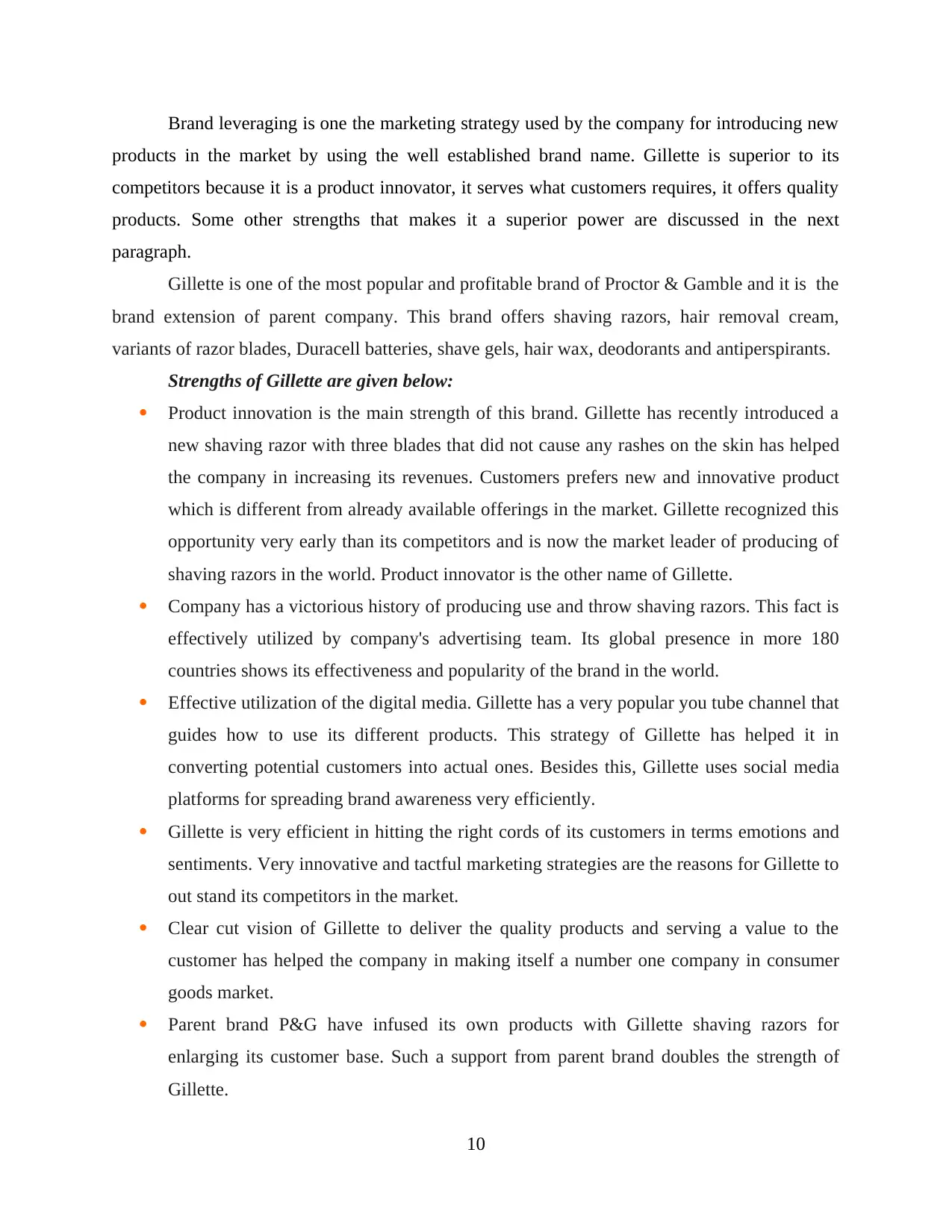
Brand leveraging is one the marketing strategy used by the company for introducing new
products in the market by using the well established brand name. Gillette is superior to its
competitors because it is a product innovator, it serves what customers requires, it offers quality
products. Some other strengths that makes it a superior power are discussed in the next
paragraph.
Gillette is one of the most popular and profitable brand of Proctor & Gamble and it is the
brand extension of parent company. This brand offers shaving razors, hair removal cream,
variants of razor blades, Duracell batteries, shave gels, hair wax, deodorants and antiperspirants.
Strengths of Gillette are given below:
Product innovation is the main strength of this brand. Gillette has recently introduced a
new shaving razor with three blades that did not cause any rashes on the skin has helped
the company in increasing its revenues. Customers prefers new and innovative product
which is different from already available offerings in the market. Gillette recognized this
opportunity very early than its competitors and is now the market leader of producing of
shaving razors in the world. Product innovator is the other name of Gillette.
Company has a victorious history of producing use and throw shaving razors. This fact is
effectively utilized by company's advertising team. Its global presence in more 180
countries shows its effectiveness and popularity of the brand in the world.
Effective utilization of the digital media. Gillette has a very popular you tube channel that
guides how to use its different products. This strategy of Gillette has helped it in
converting potential customers into actual ones. Besides this, Gillette uses social media
platforms for spreading brand awareness very efficiently.
Gillette is very efficient in hitting the right cords of its customers in terms emotions and
sentiments. Very innovative and tactful marketing strategies are the reasons for Gillette to
out stand its competitors in the market.
Clear cut vision of Gillette to deliver the quality products and serving a value to the
customer has helped the company in making itself a number one company in consumer
goods market.
Parent brand P&G have infused its own products with Gillette shaving razors for
enlarging its customer base. Such a support from parent brand doubles the strength of
Gillette.
10
products in the market by using the well established brand name. Gillette is superior to its
competitors because it is a product innovator, it serves what customers requires, it offers quality
products. Some other strengths that makes it a superior power are discussed in the next
paragraph.
Gillette is one of the most popular and profitable brand of Proctor & Gamble and it is the
brand extension of parent company. This brand offers shaving razors, hair removal cream,
variants of razor blades, Duracell batteries, shave gels, hair wax, deodorants and antiperspirants.
Strengths of Gillette are given below:
Product innovation is the main strength of this brand. Gillette has recently introduced a
new shaving razor with three blades that did not cause any rashes on the skin has helped
the company in increasing its revenues. Customers prefers new and innovative product
which is different from already available offerings in the market. Gillette recognized this
opportunity very early than its competitors and is now the market leader of producing of
shaving razors in the world. Product innovator is the other name of Gillette.
Company has a victorious history of producing use and throw shaving razors. This fact is
effectively utilized by company's advertising team. Its global presence in more 180
countries shows its effectiveness and popularity of the brand in the world.
Effective utilization of the digital media. Gillette has a very popular you tube channel that
guides how to use its different products. This strategy of Gillette has helped it in
converting potential customers into actual ones. Besides this, Gillette uses social media
platforms for spreading brand awareness very efficiently.
Gillette is very efficient in hitting the right cords of its customers in terms emotions and
sentiments. Very innovative and tactful marketing strategies are the reasons for Gillette to
out stand its competitors in the market.
Clear cut vision of Gillette to deliver the quality products and serving a value to the
customer has helped the company in making itself a number one company in consumer
goods market.
Parent brand P&G have infused its own products with Gillette shaving razors for
enlarging its customer base. Such a support from parent brand doubles the strength of
Gillette.
10
⊘ This is a preview!⊘
Do you want full access?
Subscribe today to unlock all pages.

Trusted by 1+ million students worldwide
1 out of 19
Related Documents
Your All-in-One AI-Powered Toolkit for Academic Success.
+13062052269
info@desklib.com
Available 24*7 on WhatsApp / Email
![[object Object]](/_next/static/media/star-bottom.7253800d.svg)
Unlock your academic potential
Copyright © 2020–2025 A2Z Services. All Rights Reserved. Developed and managed by ZUCOL.


